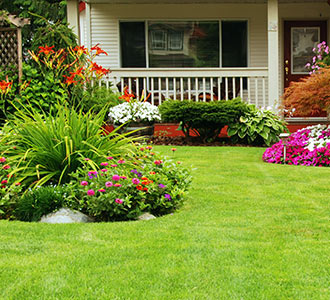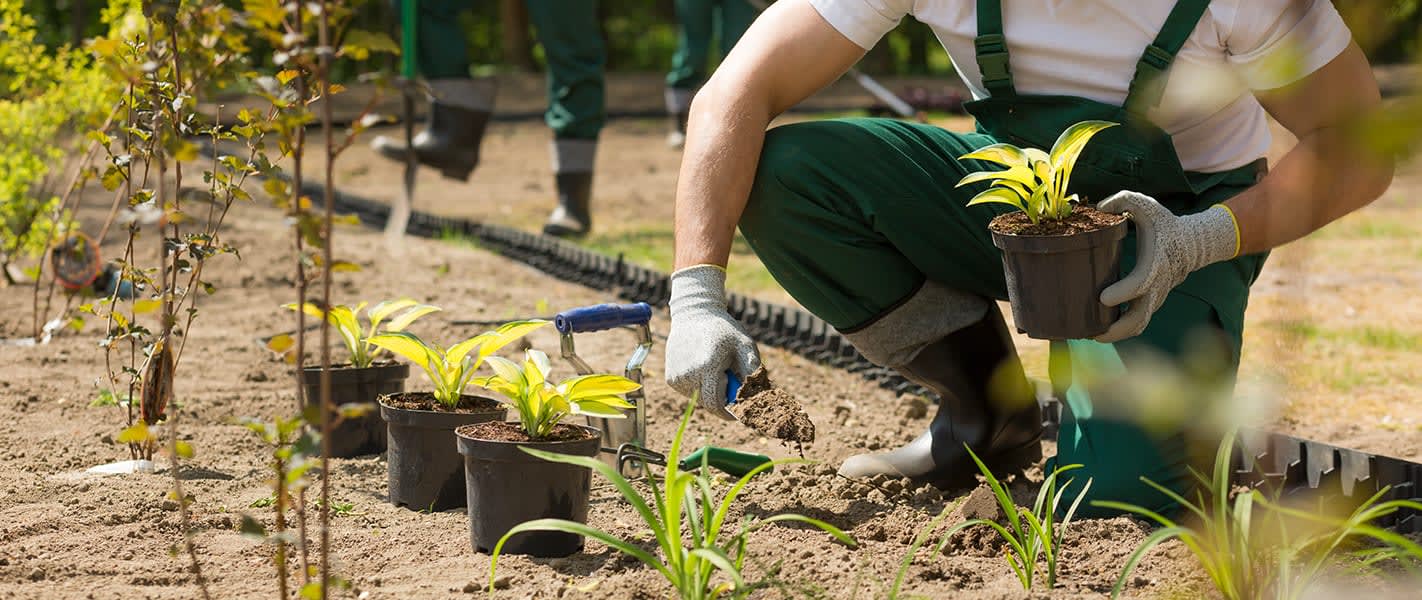A beginner’s checklist for choosing the right landscaping services
Wiki Article
Recognizing the Comprehensive Scope of Functions in Expert Landscaping Services
The comprehensive scope of specialist landscape design services encompasses a range of basic aspects - landscaping services. It includes landscape layout principles, plant choice, and hardscaping functions. In addition, it deals with irrigation systems and upkeep strategies. Each element plays an essential function in developing functional and visually pleasing exterior areas. Understanding just how these parts collaborate can disclose much regarding the art and scientific research of landscaping. However, the journey right into this elaborate field is just beginningLandscape Layout Principles
Reliable landscape layout concepts are crucial for producing unified exterior areas that boost both aesthetic charm and capability (Learn More). These concepts lead the arrangement of aspects within the landscape, making certain a natural visual experience. Secret components consist of balance, which disperses visual weight uniformly; percentage, which connects the dimension of various components to each various other and the room; and unity, which develops a feeling of integrity with constant styles and materials
Plant Selection and Setup
In the domain name of professional landscaping, plant choice and installment play a crucial duty in accomplishing a flourishing garden. Stressing native plant advantages, seasonal factors to consider, and the particular dirt and sunlight needs of each types assures a lasting and aesthetically pleasing landscape. Cautious planning in these locations not only boosts biodiversity yet additionally promotes lasting environmental health and wellness.Native Plant Advantages
Why should house owners think about native plants for their landscape design jobs? Indigenous plants offer various advantages that improve both aesthetics and environmental sustainability. They are well-adapted to neighborhood climates, needing much less water and upkeep compared to non-native varieties. This resilience lowers the requirement for chemical plant foods and chemicals, advertising a much healthier environment. Furthermore, native plants supply environment and food for local wildlife, consisting of pollinators, which can raise biodiversity in residential locations. Their familiarity with regional dirt and climate condition additionally results in better growth rates and longevity. By picking indigenous plants, house owners not only develop aesthetically attractive landscapes but additionally add to ecological preservation, making a positive influence on their neighborhood atmosphere. Consequently, indigenous plants represent a smart selection for landscape design jobs.Seasonal Plant Considerations
Home owners that have actually welcomed indigenous plants in their landscaping can better enhance their outside rooms by considering seasonal plant selections. By incorporating plants that grow in specific seasons, they can create dynamic and aesthetically enticing landscapes throughout the year. Spring might usher in vibrant blossoms like tulips and daffodils, while summertime can showcase lavish vegetation and colorful perennials. Fall introduces a palette of warm tones with goldenrods and asters, while wintertime can be highlighted with evergreens and decorative yards for appearance. Professional landscapers frequently recommend picking plants that not just complement existing indigenous species however likewise supply year-round rate of interest and support neighborhood wildlife. This thoughtful approach to seasonal plant option assures a constantly advancing and sustainable yard setting.Soil and Sunlight Demands
Effective landscape design depends upon comprehending the particular soil and sunlight requirements of plants. Various species flourish under differing conditions, needing a careful evaluation of both elements throughout the option process. Soil types, such as sandy, clay, or fertile, impact water drainage, nutrition accessibility, and origin growth. Furthermore, pH levels can affect plant health, demanding dirt testing to determine suitability. Sunshine needs differ substantially; some plants flourish in complete sunlight, while others like partial or complete color. A specialist landscaping company considers these components to assure peak growth and visual charm. By straightening plant selections with the setting's particular qualities, landscapes can accomplish sustainability, durability, and aesthetic consistency, inevitably causing effective plant establishment and long-lasting upkeep.Hardscaping Attributes and Construction

While landscaping frequently stimulates photos of lavish plant and dynamic flowers, hardscaping attributes play an important duty in defining outside areas. These elements, which consist of outdoor patios, sidewalks, maintaining wall surfaces, and ornamental stonework, offer framework and functionality to gardens and backyards. Hardscaping uses products such as concrete, wood, stone, and block, permitting for varied layouts that match the natural landscape.
The building of hardscaping attributes calls for cautious preparation and execution to ensure toughness and aesthetic charm. Professionals assess site problems, water drainage, and spatial partnerships to produce cohesive outdoor environments. Proper installation strategies are essential, as they stop problems like erosion and shifting in time.
Integrating hardscaping not just boosts the aesthetic passion of a home but additionally promotes outside tasks, making it a basic element of comprehensive landscaping services. Inevitably, thoughtful hardscaping adds to both the capability and appeal of outdoor spaces.
Watering Solutions and Water Management
Effective watering systems and water management are essential components of professional landscape design, as they ensure that plants obtain the essential hydration for excellent growth. These systems can differ from straightforward drip watering arrangements to innovative automated automatic sprinkler, developed to satisfy the certain needs of varied landscapes. Correct water management not only maximizes water use, decreasing waste, however additionally improves plant wellness and decreases disease dangers.Landscaping professionals analyze numerous variables, including dirt type, plant types, and local environment, to establish tailored watering services. Furthermore, integrating rainwater harvesting strategies can further boost sustainability and performance. Routine maintenance of watering systems is necessary to preserve functionality and prevent leakages, which can cause water loss and boosted expenses (Learn More). Eventually, a properly designed watering system plays a critical duty in protecting the visual allure of exterior areas while promoting environmental stewardship within expert landscaping methods
Grass Treatment and Upkeep Strategies
Lawn treatment and upkeep approaches are fundamental for achieving a rich, healthy and balanced backyard that improves the general landscape. These strategies include various techniques targeted at advertising suitable growth and visual appeal. Routine mowing is crucial, as it urges thick, even development while stopping weeds from developing. Additionally, correct fertilization supplies necessary nutrients, with applications customized to the details lawn kind and soil conditions.Watering techniques ought to concentrate on deep, irregular watering to encourage root advancement, while aeration enhances dirt framework and promotes nutrient absorption. Insect and illness administration is additionally vital; recognizing problems early permits efficient treatments that reduce damage.
Overseeding can revitalize thin or broken yards, enhancing thickness and shade (landscaping). By executing these targeted grass treatment methods, landscape design specialists can guarantee that yards remain healthy and vibrant throughout the seasons, significantly adding to the general elegance of the residential or commercial property
Seasonal Landscape Treatment and Upkeep
As the seasons adjustment, correct landscape care comes to be crucial for preserving the health and charm of exterior areas. Each period presents one-of-a-kind obstacles and needs. In springtime, landscape professionals concentrate on pruning, growing, and fertilizing to urge development. Summertime needs routine watering, weed control, and bug management to safeguard freshly established plants.
Throughout the year, seasonal landscape upkeep guarantees that outside locations continue to be healthy and aesthetically appealing. Expert services can give tailored maintenance strategies that adapt to the particular needs of each season, allowing home owners to take pleasure in vivid landscapes year-round. On the whole, seasonal treatment is a vital facet of specialist landscape design that advertises longevity and aesthetic value.

Sustainable Landscaping Practices
An expanding variety of residential property owners are accepting lasting landscape design practices to create eco-friendly outside spaces. These methods focus on preserving resources, improving biodiversity, and reducing ecological effect. Indigenous plants are typically picked for their low water needs and compatibility with neighborhood environments, reducing the requirement for chemical plant foods and pesticides. Rain yards and permeable paving are used to here manage stormwater drainage, promoting groundwater recharge and minimizing erosion.Furthermore, lasting landscaping includes organic gardening strategies that focus on dirt wellness and advertise natural bug control. Effective watering systems, such as drip irrigation and rainwater harvesting, help optimize water use. Additionally, landscape developers progressively promote for making use of recycled materials, such as recovered timber and stones, to lessen waste. By adopting these lasting techniques, building proprietors not just contribute to eco-friendly conservation but also create aesthetically pleasing environments that can love minimal maintenance.
Often Asked Concerns
Exactly how Long Does a Landscaping Project Commonly Require To Full?
Generally, a landscaping job can take anywhere from a couple of days to several weeks to complete, relying on the project's size, complexity, and layout demands. Aspects such as climate and source accessibility likewise influence timelines.What Elements Influence the Expense of Landscape Design Services?
Numerous aspects affect landscaping solution costs, including project size, design complexity, worldly top quality, labor expenses, geographical area, and seasonal demand. Each aspect adds uniquely to the general financial demands of a landscaping job.
Are Landscape Design Services Available Year-Round?
Landscape design services are usually available year-round, although accessibility might differ based on area, seasonal climate condition, and specific solution offerings. Some services may be restricted during severe weather or off-peak periods.Do Landscaping Business Offer Service Warranties on Their Work?
Many landscaping firms do provide service warranties on their work, which can differ in length and insurance coverage. Customers are urged to ask about details terms, guaranteeing they recognize what is ensured and any conditions that use.Can I Style My Landscape Without Specialist Assist?
Yes, people can create their landscapes without specialist aid. Nonetheless, they might lack expertise in plant choice, design, and environmental factors to consider, potentially causing less efficient styles that could require costly modifications later.In the domain name of expert landscape design, plant choice and installation play a vital role in attaining a growing garden. Property owners that have embraced indigenous plants in their landscape design can further boost their outside spaces by taking into consideration seasonal plant selections. Effective landscaping hinges on comprehending the particular dirt and sunshine requirements of plants. Effective watering systems and water administration are important parts of professional landscape design, as they ensure that plants obtain the required hydration for ideal growth. Landscape design professionals examine various variables, including soil kind, plant types, and regional climate, to create customized irrigation options.
Report this wiki page